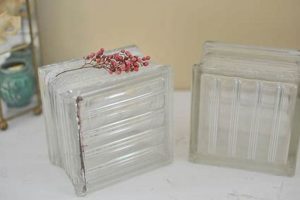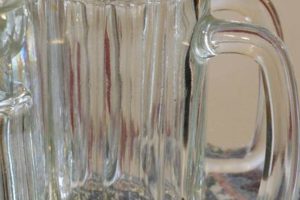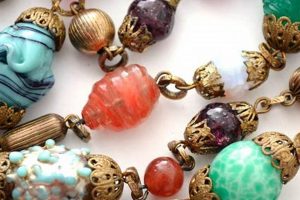These spherical or cylindrical objects, often crafted from thick, durable glass, once served a vital function in maritime navigation and fishing. They provided buoyancy for fishing nets, longlines, and navigational markers, enabling them to remain visible on the water’s surface. Examples can be found in a variety of sizes and colors, originally chosen for visibility in different sea conditions.
Their significance extends beyond their practical application. They represent a tangible connection to maritime history, reflecting the ingenuity and resourcefulness of past generations of seafarers. The unique imperfections and wear acquired over time add to their character and historical value, making them prized collectibles. They are a testament to a bygone era of seafaring and a reminder of the reliance on natural materials.
The following sections will delve into the history, manufacturing processes, regional variations, and the contemporary appeal of these fascinating nautical artifacts. We will examine their evolution from utilitarian tools to sought-after decorative items and collectibles, exploring the factors that contribute to their value and desirability.
Collecting and Preserving Historic Maritime Floats
Acquiring and maintaining these fragile artifacts requires diligence and informed decision-making. The following guidelines offer insights into evaluating authenticity, preserving condition, and displaying these historical objects.
Tip 1: Examine for Authenticity. Verify the presence of a pontil mark, a rough scar on the bottom of the object indicating it was hand-blown. The absence of this mark can suggest a more recent, mass-produced imitation.
Tip 2: Assess Condition Carefully. Scrutinize the glass for cracks, chips, or internal flaws. Even minor imperfections can significantly impact value and structural integrity. Avoid items with extensive damage, particularly those that compromise the structural soundness.
Tip 3: Research Regional Variations. Identify the country or region of origin through markings, color variations, and manufacturing techniques. Different regions employed distinct styles, which contributes to their historical significance.
Tip 4: Implement Proper Cleaning Techniques. Use mild soap and water with a soft cloth. Abrasive cleaners can scratch the glass surface and diminish its original luster. Avoid harsh chemicals, which may react negatively with the glass composition.
Tip 5: Utilize Secure Display Methods. Employ stable display stands or mounts to prevent accidental falls or damage. Ensure the base is adequately sized to support the weight and shape of the object.
Tip 6: Control Environmental Factors. Protect from direct sunlight, extreme temperature fluctuations, and high humidity. Prolonged exposure to these elements can lead to fading, cracking, or structural degradation.
Tip 7: Document Provenance. Maintain records of purchase, including date, location, and seller information. Documentation of origin and history enhances value and provides context.
Adherence to these principles ensures that these tangible pieces of maritime history are not only acquired but also preserved for future appreciation. Diligence in assessment and maintenance ensures their enduring historical and aesthetic value.
The concluding section will explore the investment potential and market trends associated with these historical artifacts.
1. Maritime Heritage Connection
The tangible link between these glass objects and maritime heritage stems from their integral role in historical seafaring activities. These tools served as indispensable components of fishing nets, longlines, and navigational markers, effectively supporting the livelihoods of maritime communities. The practical consequence of their widespread use is the accumulation of a physical record of past maritime endeavors. The correlation between seafaring history and these now-relics lies in their function as essential, everyday items during an era dominated by sail and traditional fishing methods.
Their existence provides insights into historical fishing techniques, trade routes, and technological adaptations to marine environments. For example, the presence of a glass float bearing specific markings or colors in a particular region can indicate historical trade relationships or the prevalence of specific fishing practices. The endurance of these floats through decades of exposure to the elements serves as a testament to the resourcefulness and ingenuity of past mariners. Understanding this heritage connection enables a deeper appreciation of the evolution of maritime technology and its impact on coastal communities.
In summary, the connection between maritime heritage and these buoyant artifacts is a direct result of their practical applications and historical significance within seafaring communities. Appreciating this connection requires recognizing their role as essential tools that directly supported maritime activities, creating a tangible link to the past. This understanding is not without its challenges, requiring detailed research into historical fishing practices and regional variations in buoy design, but it ultimately enhances the appreciation of the cultural and technological legacy embedded within these historical objects.
2. Hand-blown craftsmanship
The hand-blown nature of these historical objects is intrinsically linked to their value and historical significance. This method of production distinguishes them from modern, mass-produced items, imparting unique characteristics to each individual piece and creating distinctions in shape and design.
- Unique Imperfections
The hand-blowing process inevitably results in slight variations in size, shape, and glass thickness. These imperfections, such as small bubbles or subtle distortions, are not considered flaws but rather hallmarks of authenticity and evidence of the artisan’s hand. These variations contribute to the unique character of each float, rendering it one-of-a-kind. For instance, two floats produced in the same workshop may exhibit minor differences in color intensity or the distribution of air bubbles within the glass.
- Pontil Mark Significance
A telltale sign of hand-blown glass is the presence of a pontil mark, a rough scar located on the bottom of the float. This mark is the residual effect of the pontil rod, an iron rod used to hold the glass object during the final stages of production. The presence of a distinct pontil mark is a strong indicator of authenticity and helps differentiate genuine historical pieces from modern reproductions, which often lack this feature.
- Artisan Skill and Technique
Hand-blowing requires considerable skill and experience. Glassblowers meticulously shape the molten glass using specialized tools and techniques. Variations in technique, influenced by regional traditions and individual artisan styles, contribute to the diverse range of shapes, sizes, and colors observed in these collectibles. The skilled manipulation of molten glass is evident in the subtle nuances of each finished piece, which can be highly prized by collectors.
- Limited Production Capacity
The hand-blown process is inherently slower and more labor-intensive than automated production methods. This inherent limitation in production capacity contributed to the scarcity of floats, especially those produced in specific regions or during particular periods. The relatively low production volume further enhances the desirability and value of authentic, hand-blown examples.
The evidence of hand-blown craftsmanship in these floats is central to their appeal. The unique imperfections, the presence of a pontil mark, the evidence of artisan skill, and the limited production contribute to their value as historical artifacts. Collectors often seek out examples that clearly demonstrate these attributes, further emphasizing the importance of hand-blown craftsmanship in evaluating the authenticity and historical importance.
3. Regional manufacturing variations
Distinct regional variations in manufacturing techniques significantly influence the characteristics, appearance, and historical value of maritime floats. These variations reflect localized resources, traditions, and technological capabilities, resulting in discernible differences among examples originating from different geographic areas.
- Color Composition and Availability
The availability of raw materials, such as specific minerals used in glass production, dictated the range of colors produced in various regions. For example, Japanese floats often exhibit shades of blue and green due to the availability of specific additives, while Scandinavian examples may feature a prevalence of clear or amber glass. This geographical influence on color palettes serves as a valuable indicator of origin.
- Shape and Design Preferences
Regional preferences for specific shapes and designs emerged based on practical considerations, such as wave conditions, fishing techniques, and intended use. For instance, spherical floats were commonly used in regions with calmer waters, while cylindrical or egg-shaped floats were favored in areas with rougher seas to enhance stability and visibility. The shape can correlate with region, like rounded Japanese spheres vs barrel-shaped floats from other areas.
- Markings and Identifiers
Certain regions incorporated unique markings or identifiers onto their floats to indicate ownership, manufacturer, or intended purpose. These markings may include embossed characters, symbols, or patterns that provide crucial clues about the float’s origin and history. For instance, some Scandinavian floats feature intricate patterns etched into the glass, which helped fishermen identify their equipment at sea.
- Glassblowing Techniques and Tooling
Variations in glassblowing techniques and the types of tools employed by artisans further contributed to regional differences. Some regions favored free-blowing techniques, resulting in organic shapes and unique imperfections, while others utilized molds to create more uniform and standardized products. The specific tools used, such as the pontil rod or blowing iron, also varied, leaving distinct marks on the finished product.
In conclusion, the study of regional manufacturing variations is crucial for accurately identifying the origin, history, and value of these maritime artifacts. By examining characteristics such as color composition, shape, markings, and glassblowing techniques, collectors and historians can gain insights into the unique cultural and technological context in which each float was produced. These variations create a rich tapestry of maritime history, providing tangible evidence of the ingenuity and resourcefulness of seafaring communities across the globe, as demonstrated by differences in the creation of glass vintage buoys in regions like Japan, Scandinavia, and North America.
4. Material Durability
The enduring nature of these maritime objects is directly attributable to the inherent durability of the glass employed in their construction. This robustness was not accidental but rather a deliberate design consideration, essential for withstanding the harsh marine environment. The ability of the glass to resist constant exposure to saltwater, extreme temperature fluctuations, and physical impacts was paramount to its functionality. The thickness of the glass, typically significantly greater than that used in household items, further enhanced its resistance to breakage. A direct consequence of this material durability is the survival of many of these objects for decades, even centuries, after their original use, enabling their present-day appreciation as historical artifacts.
The composition of the glass also played a critical role in its resilience. Specific additives were often incorporated into the glass mixture to increase its strength, resistance to chemical corrosion, and ability to withstand thermal shock. For example, some manufacturers added lime or alumina to the glass to improve its durability in marine environments. The selection of appropriate raw materials and manufacturing techniques directly contributed to the longevity of these objects. This material durability enabled the sustained performance of maritime floats in demanding marine operations, and also enabled their survival and present-day valuation. As a result, these floating objects are still appreciated today as collectibles and decorative objects.
Understanding the relationship between material durability and the survival of these maritime objects is essential for assessing their authenticity, condition, and value. The presence of significant damage or degradation can indicate exposure to particularly harsh conditions or the use of lower-quality materials. While some level of wear and tear is expected in vintage items, excessive damage may compromise their structural integrity and historical significance. Therefore, appreciating the practical importance of material durability is crucial for collectors, historians, and anyone interested in preserving these tangible links to maritime past.
5. Decorative aesthetic appeal
The allure of these objects, beyond their historical significance, rests significantly on their inherent visual appeal. The combination of form, color, and texture contributes to their desirability as decorative items. Their spherical or cylindrical shapes, often exhibiting a pleasing symmetry, lend themselves well to various display settings. The color variations, ranging from translucent greens and blues to vibrant ambers and reds, provide visual interest and complement diverse interior design schemes. The tactile quality of the glass, often subtly textured by years of exposure to the sea, adds another layer of sensory engagement.
The aesthetic value is amplified by the historical context. The visible signs of age, such as minor scratches, imperfections, and the patina acquired over time, enhance their character and create a sense of authenticity. For example, a collection of these floats displayed in a nautical-themed room can evoke a sense of maritime history and adventure, while a single float strategically placed in a minimalist setting can serve as a striking focal point. Interior designers frequently incorporate these floats into their projects, leveraging their unique visual qualities to create distinctive and memorable spaces. The combination of visual appeal and historical context transforms these practical objects into conversation pieces and artistic elements.
Appreciating the decorative potential of these historical objects requires an understanding of their inherent aesthetic qualities and their ability to complement diverse design styles. Their enduring popularity as decorative items reflects a broader appreciation for the beauty of imperfection, the allure of history, and the enduring appeal of nautical themes. Identifying and preserving the aspects of visual appeal ensures the sustained value and relevance of these artifacts, bridging the gap between maritime past and contemporary design.
Frequently Asked Questions
The following questions address common inquiries and misconceptions concerning these maritime artifacts, offering concise and informative responses.
Question 1: What distinguishes an authentic maritime float from a reproduction?
Authenticity is primarily determined by examining the presence of a pontil mark, a rough scar on the base of the float indicating hand-blown production. Additionally, authentic floats often exhibit unique imperfections and variations in glass thickness absent in mass-produced replicas. Careful scrutiny of these features aids in differentiation.
Question 2: How does the color of a maritime float influence its value?
Rarity and regional significance often determine value. Certain colors, such as cobalt blue or deep red, are less common than green or clear glass and may command higher prices. The historical context and regional origins associated with specific colors also contribute to valuation.
Question 3: What are the recommended cleaning procedures for these delicate objects?
Gentle cleaning with mild soap and water is advisable. Abrasive cleaners should be avoided as they can scratch the glass surface. A soft cloth should be used to gently wipe the float, removing any accumulated dirt or debris. Harsh chemicals should be avoided.
Question 4: How should maritime floats be displayed to prevent damage?
Stable display stands or mounts are recommended. Ensure the base adequately supports the weight and shape of the float. Direct sunlight and extreme temperature fluctuations should be avoided as they can lead to fading or cracking. Proper display contributes to preservation.
Question 5: How does regional origin impact the value and desirability of maritime floats?
Floats originating from specific regions, such as Japan or Scandinavia, may possess unique characteristics or historical associations that increase their value. Regional variations in shape, color, and markings contribute to their collectibility and historical significance.
Question 6: Are damaged maritime floats worth collecting, or should one focus solely on pristine examples?
The presence and severity of damage influence the value. Minor imperfections or wear acquired over time may enhance character, while significant cracks or structural damage can diminish value. The desirability of damaged examples depends on individual preferences and the rarity of the float.
These frequently asked questions offer insights into the characteristics, care, and value of these maritime artifacts. A comprehensive understanding aids in informed collecting and preservation.
The subsequent section will explore the role of these objects in contemporary art and design, examining their influence on modern aesthetics.
Vintage Glass Buoys
This exploration has examined aspects of these glass objects, from their historical maritime applications to their contemporary appeal as collectibles and decorative items. The discussion has encompassed the significance of hand-blown craftsmanship, regional manufacturing variations, material durability, and aesthetic qualities that contribute to their enduring desirability. Understanding the authentication, preservation, and display of these artifacts is crucial for collectors and historians alike.
The preservation of these tangible links to maritime past remains vital. Further research into the historical context, manufacturing techniques, and regional variations can enhance the appreciation of these objects. Continued vigilance in identifying and safeguarding authentic examples will ensure that future generations can connect with the history and artistry embodied within each artifact.







